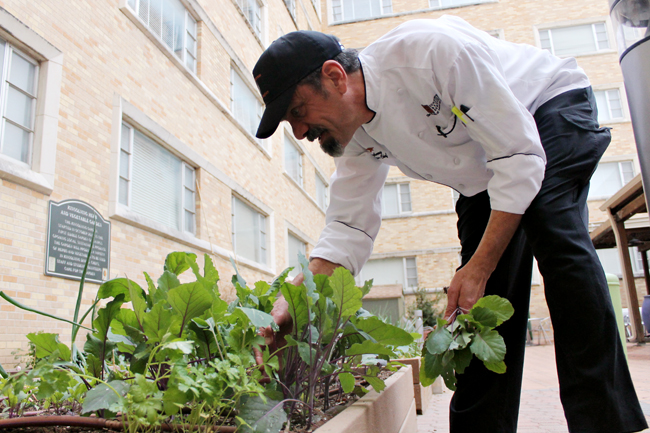Austin is known for its locally grown foods, but the Jester dining halls take it a step further. Since December, some of the produce on Jester’s shelves has been grown in a student-run garden just outside.
The new garden was commissioned in September of last year after the success of the Kinsolving garden, which was constructed in 2009 to provide vegetables and herbs to the chefs in UT dining halls.
Green Corps, an organization created this year by the University to educate students about the importance of locally grown food, provides assistance in maintaining the two residence hall gardens at the University. Before Green Corps, kitchen staff had to maintain the garden.
“We really wanted staff and students aware of environmentally friendly ways of eating and living,” said Rachel Markowitz, student manager of Green Corps. “If you’re going to talk about sustainable food, you should grow some of your own.”
Currently, the garden’s main produce is lettuce because of its fast growth rate. Markowitz said Green Corps will most likely plant tomatoes, peppers, eggplants and peas in the spring.
According to Hunter Mangrum, environmental specialist for the Division of Housing and Food Service, Green Corps has harvested lettuce and radishes about four times this season and was able to harvest six to eight pounds of the vegetables in total. The amount of produce harvested from the gardens is limited because Green Corps’ mission is to grow things that thrive in Central Texas without needing to use pesticides, Markowitz said.
Unlike many home gardens that are watered with hoses or sprinklers, the University’s residence hall gardens each have an 8,000-gallon rainwater collection tank that runs off of solar power. The tanks collect and filter rainwater from the rooftops and use drip irrigation lines to water the plants.
“[The gardens] don’t consume any grid electricity or water,” Mangrum said. “There’s no city water or UT electricity that goes into this.”
The Division of Housing and Food Services has no concrete plans to build another residence hall garden, but it does have a group of students planning a pilot mushroom garden that can be replicated in dark corners on campus.
“We’re like this little concrete island in the middle of the city, but we’re growing produce at the same time and using students in a way that they can get experience that they wouldn’t have otherwise,” Mangrum said.
Campus executive chef Robert Mayberry said he liked the idea of growing organic produce at the University because he wants to provide more sustainable food to students.
“I love having it right there, fresh from the garden when I’m ready to use it,” Mayberry said. “It makes a big difference in quality and flavor.”
The amount of sustainable, local and organic food purchased for the dining halls makes up over 20 percent of the total food budget, Mayberry said.
According to Mayberry, the main supplier of produce for on-campus dorms is US Food Services, and, for the last four to five years, the University has worked with the Sustainable Food Center to use local, small farms.





















